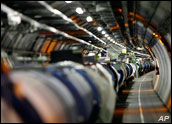
The long search for the fabled Higgs boson may be drawing to its end.

Rolf Heuer, director-general of the European Organization for Nuclear Research, CERN, has reportedly stated that the particle’s existence will either be proved or disproved within 12 months.
Heuer’s statement was backed by two other prominent scientists: Pier Oddone of Fermilab, the only high-energy physics laboratory in the United States; and Atsuto Suzuki of KEK, Japan’s high-energy accelerator research organization.
The Higgs boson is a hypothetical massive elementary particle, the existence of which is predicted by the Standard Model of particle physics.
It would help explain why some particles are massive and others are massless. The Higgs boson is also believed to have helped shaped the universe after the Big Bang almost 14 billion years ago.
If scientists can definitely prove that the Higgs boson doesn’t exist, they’d need to find another explanation for how fundamental particles acquire their mass, Katie Yurkewicz, communications director at Fermilab, told TechNewsWorld.
Tally-Ho, Higgsie
Scientists around the world have been trying to track down the Higgs boson for years using highly sophisticated and complex equipment.
The excitement began really ramping up this year.
In July, Fermilab, which comes under the United States Department of Energy’s Office of Science, announced that scientists running experiments there were closing in on confirming whether or not the Higgs boson does indeed exist.
The experiments were run at the Fermilab Collider Detector (CDF) and by the DZero Experiment.
DZero is the collaborative work of scientists from around the world conducting research on the fundamental nature of matter. Their experiments are conducted at Fermilab’s Tevatron Collider, which was shut down Sept. 30.
In August, two experimental collaborations at the CERN Large Hadron Collider narrowed down the possible mass of a Higgs boson. They excluded with 95 percent certainty the existence of a Higgs over most of the mass region from 145 GeV to 466 GeV.
One GeV is one giga-electron volt. The eV is a measure of mass in particle physics.
This finding meant the search would be restricted to particles with a mass of less than 145 GeV.
How to Find a Higgs Boson
The CDF and DZero collaborations applied well-established techniques used to search for the Higgs boson to observe extremely rare collisions that produce pairs of heavy bosons (WW or WZ) that decay into heavy quarks.
This process closely mimics the production of a W boson and a Higgs particle, with the Higgs decaying into a bottom quark and antiquark pair.
Both Tevatron experiments are searching for that pair, which will indicate Higgs bosons exist.
This type of decay has never been measured before.
Bottom quarks have a bare mass that’s a bit more than four times that of a proton, and this, combined with other factors, makes them relatively easy to identify.
“Particle physicists have been searching for the Higgs boson for years,” Fermilabs’ Yurkewicz stated. “The reason we’re very close to a final answer today is the large amount of data that’s now available to the scientists — and the advance in analysis techniques that the scientists have made over the years.”
There are no funding issues, Yurkewicz said.
Making Light of FTL Claims
Separately, the three scientists from CERN, Fermilab and KEK expressed doubt about a report that particles had recently exceeded the speed of light in an experiment involving the CERN LHC.
Scientists shot a high-intensity, high-energy beam of muon neutrinos from the CERN SPS accelerator in Geneva towards the LNGS underground laboratory at Gran Sasso, Italy, 730 km (453 miles) away and measured the speed at which the neutrinos traveled.
The particles apparently exceeded the speed of light, leading the scientists to invite further scrutiny.
If those findings are correct, scientists will have to rethink several basic assumptions, because the current model of space and time is based on the premise that the speed of light is the theoretical maximum.
“Such an experimental finding would completely overturn our understanding of physical reality,” Michael Witherell, vice chancellor for research at UC Santa Barbara and the former head of Fermilab, told TechNewsWorld in an earlier interview.





















































